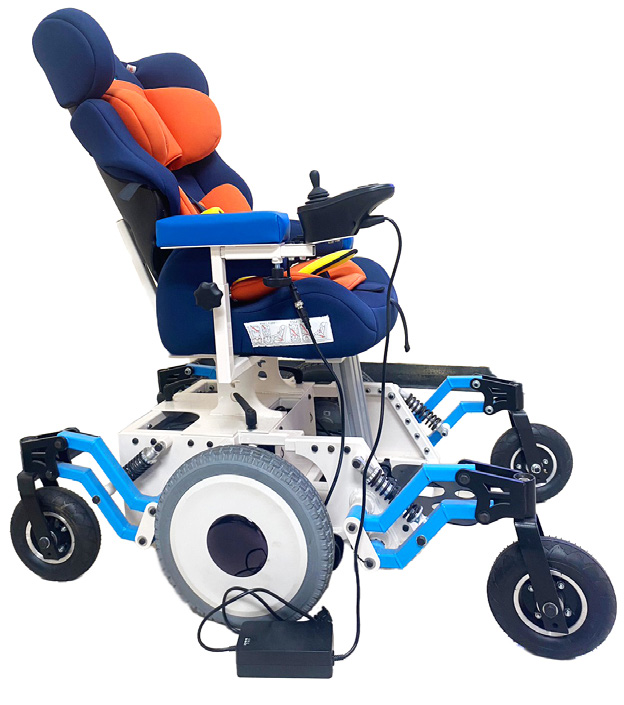Assistive Technology for Children with Cerebral Palsy
Main Article Content
Abstract
Cerebral palsy is a group of disorders affecting an individual’s ability to move, maintain balance and posture. Beyond affecting movement and posture, cerebral palsy also influences development and intellect, leading to challenges in speech, vision, and hearing. Assistive technology plays a crucial role in improving the quality of life and enhancing the capabilities of children with cerebral palsy. Assistive technology is designed to help individuals overcome physical limitations, promote their independence and participation in various activities. Using assistive technology for children with cerebral palsy offers wide range of advantages that can significantly improve their quality of life, independence, and overall well-being. This article reviews different types of assistive technology including mobility and positioning devices, communication devices, vision and hearing aid devices, environmental controls, the activity of daily living devices, and learning assistant devices used for children with cerebral palsy. Assistive technology encompasses various devices, each tailored to its function, aimed at enhancing both structural and functional aspects, such as the utilization of ankle-foot orthoses (AFOs) to regulate walking mechanics. It also involves tools that augment activity execution e.g. communication boards and assistive listening devices. Furthermore, alterations to the environment e.g. creating accessible bathrooms, that diminish or eradicate barriers to engagement, are also regarded as forms of assistive technology. Each assistive technology or device is highly individualized based on each child’s needs, abilities, and conditions. The use of assistive technology will be most effective and beneficial when the users learn how to use that technology or device by themselves properly and independently.
Article Details

This work is licensed under a Creative Commons Attribution-NonCommercial-NoDerivatives 4.0 International License.
References
Vitrikas K, Dalton H, Breish D. Cerebral Palsy: An Overview. Am Fam Physician. 2020 Feb 15;101(4):213-220. PMID: 32053326.
Brandenburg JE, Fogarty MJ, Sieck GC. A Critical Evaluation of Current Concepts in Cerebral Palsy. Physiology (Bethesda). 2019 May 1;34(3):216-229. doi: 10.1152/physiol.00054.2018. PMID: 30968751; PMCID: PMC7938766.
Gulati S, Sondhi V. Cerebral Palsy: An Overview. Indian J Pediatr. 2018 Nov;85(11):1006-1016. doi: 10.1007/s12098-017-2475-1. Epub 2017 Nov 20. PMID: 29152685.
Novak I, Hines M, Goldsmith S, Barclay R. Clinical prognostic messages from a systematic review on Cerebral Palsy. Pediatrics. 2012;130(5). doi:10.1542/peds.2012-0924
Paul S, Nahar A, Bhagawati M, Kunwar AJ. A review on recent advances of Cerebral Palsy. Oxidative Medicine and Cellular Longevity. 2022;2022:1–20. doi:10.1155/2022/2622310
Wimalasundera N, Stevenson VL. Cerebral palsy. Pract Neurol. 2016 Jun;16(3):184-94. doi: 10.1136/practneurol-2015-001184. Epub 2016 Feb 2. PMID: 26837375.
Gilson KM, Davis E, Reddihough D, Graham K, Waters E. Quality of life in children with cerebral palsy: implications for practice. J Child Neurol. 2014 Aug;29(8):1134-40. doi: 10.1177/0883073814535502. Epub 2014 May 27. PMID: 24870369.
Krigger KW. Cerebral palsy: an overview. Am Fam Physician. 2006 Jan 1;73(1):91-100. PMID: 16417071.
Tantilipikorn P, Watter P, Prasertsukdee S. Identifying assessment measures and interventions reported for Thai children with cerebral palsy using the ICF-CY framework. Disability and Rehabilitation. 2011;34(14):1178–85. doi:10.3109/09638288.2011.637603
Borg J, Khasnabis C, Berman-Bieler R, Mitra G, Myhill W, Raja DS. Assistive technology for children with disabilities: Creating opportunities for education, inclusion and participation a discussion paper [Internet]. 2015 [cited 2023 Feb 11]. Available from: https://docs.edtechhub.org/lib/DPLSVVT4
Zupan A, Jenko M. Assistive technology for people with cerebral palsy. East. J. Med. 2012;17:194–7.
Seating, positioning, and mobility - oklahoma able tech [Internet]. 2023 [cited 2023 Mar 11]. Available from: https://www.okabletech.org/at-discovery/seating-positioning-and-mobility/
Webster JB, Murphy D, Alexander TA, Nelson LM. Wheeled Mobility: Evaluation for Orthotic Seating and Positioning. In: Atlas of orthoses and assistive devices. Philadelphia, PA: Elsevier; 2019. p. 383–9.
Explore Assistive Technology (AT) from AT3 Center [Internet]. [cited 2023 Mar 12]. Available from: https://exploreat.net/at-discovery/seating-positioning-mobility
Myrden A, Schudlo L, Weyand S, Zeyl T, Chau T. Trends in communicative access solutions for children with cerebral palsy. Journal of Child Neurology. 2014;29(8):1108–18. doi:10.1177/0883073814534320
Assistive devices - aids for cerebral palsy [Internet]. [cited 2023 Mar 14]. Available from: https://www.cerebralpalsyguide.com/treatment/assistive-devices
Webster JB, Murphy D, Oliver M. Communication Devices and Electronic Aids to Activities of Daily Living. In: Atlas of orthoses and assistive devices. Philadelphia, PA: Elsevier; 2019. p. 403–17.
Types of Assistive Technology (AT) [Internet]. 2022 [cited 2023 Mar 14]. Available from: https://mn.gov/admin/at/getting-started/understanding-at/types
Singh IP, Misra A, Maurya A, Verma A. Technical Review of Smart Assistive Devices for Visually impaired people. 2023 4th International Conference for Emerging Technology (INCET). 2023; doi:10.1109/incet57972.2023.10170619
Jackman M, Sakzewski L, Morgan C, Boyd RN, Brennan SE, Langdon K, et al. Interventions to improve physical function for children and young people with Cerebral Palsy: International Clinical Practice Guideline. Developmental Medicine & Child Neurology. 2021;64(5):536–49. doi:10.1111/dmcn.15055
Learning Disabilities Association of Ontario. Assistive technology for students with learning disabilities [Internet]. 2018 [cited 2023 Mar 14]. Available from: https://www.ldatschool.ca/assistive-technology
Batorowicz B, Missiuna CA, Pollock NA. Technology supporting written productivity in children with learning disabilities: A critical review. Canadian Journal of Occupational Therapy. 2012;79(4):211–24. doi:10.2182/cjot.2012.79.4.3
Nordström T, Nilsson S, Gustafson S, Svensson I. Assistive technology applications for students with reading difficulties: Special education teachers’ experiences and perceptions. Disability and Rehabilitation: Assistive Technology. 2018;14(8):798–808. doi:10.1080/17483107.2018.1499142
Hunt PF. Inclusive education: The case for early identification and early intervention in Assistive Technology. Assistive Technology. 2021;33(sup1). doi:10.1080/10400435.2021.1974122






